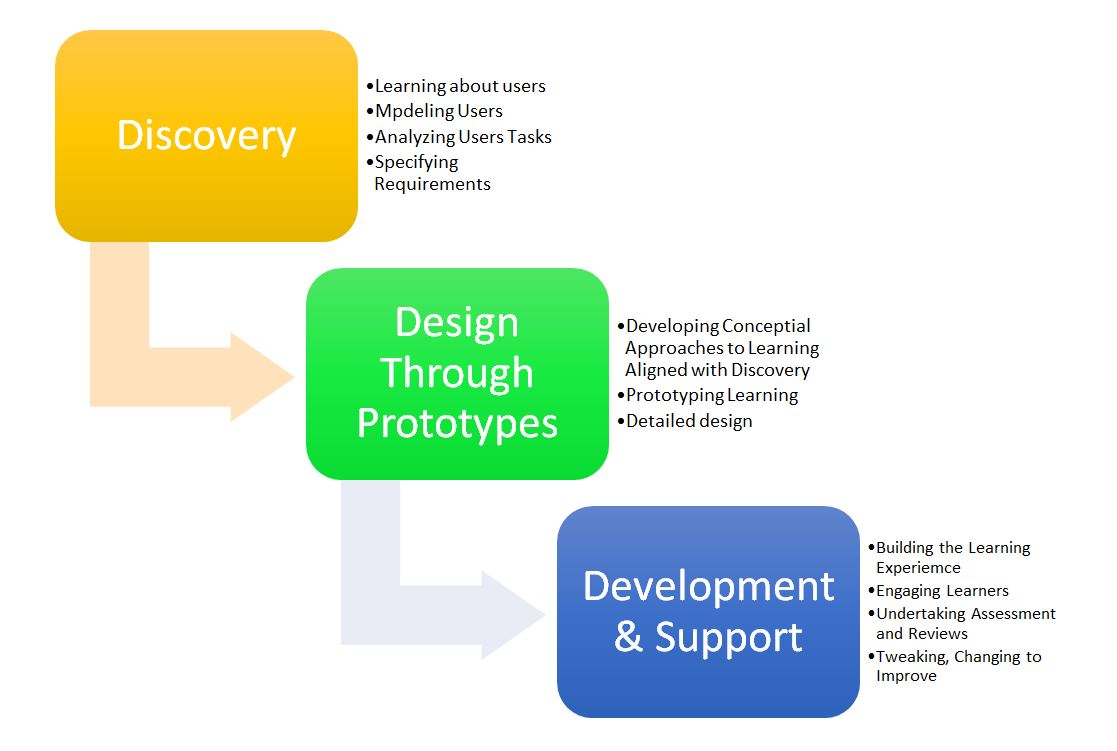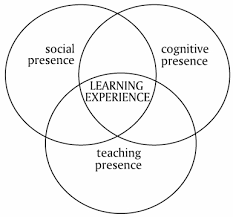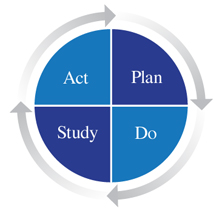Have you heard comments like this about online learning courses from faculty colleagues or students?
“I am not sure what we are supposed to do when...”
“There is no interaction, no feeling of belonging, no presence – I didn’t want to read an encyclopedia, I wanted to learn!”
“I hated this course. PowerPoints, a disembodied voice at the end of the phone lecturing…”
Even well intentioned designs can go wrong.
Some online courses are poorly thought through and designed and do not reflect what we know about adult learning, student engagement and learning outcomes, the importance of interaction and feedback and the need for presence. In fact, a number of courses are designed as replicas of classroom courses rather than as courses purposely designed for an online learning environment: what works in a classroom may or may not work online.
Understanding Design
Design is a discipline and process. It begins and ends with the needs of students and requires an in-depth knowledge of who students are, what they expect and what they bring to the task of learning for a specific course. That is, rather than asking “what do I want to teach these students?”, the question that drives design for learning is “what is it that these students need to know, understand and be able to use as a result of taking this course?”. Design is therefore a user-centred process aimed at achieving high levels of user engagement and satisfaction. We can show this process by means of a simple model:

Figure 1: The Design Process
While this captures the essence of this work, a fulsome explanation can be helpful.
Discovery Phase – Three Key Tasks
There are several components to this design stage, but the keys are these three: (a) understand who the students will be and what they know / don’t know about the knowledge and skills they will be required to study; (b) develop an in depth understanding of the knowledge and skills students will need to master during their work on this course – what is essential, helpful and “nice to have” – and how the knowledge and skills will be assessed, both in terms of helping students learn (assessment for learning) and it terms of mastery (assessment of learning); and (c) discovering what resources – especially free to use, open educational resources (OER) are available to support student learning.
Matching learning requirements for the course with available resources is an obvious challenge. There are so many resources available; how do we choose the most appropriate? The common solution is to find a textbook that is the best fit to the purposes of the course. An increasingly used approach is to customize a text for the course – a service now available from major publishers like Pearson or McGraw Hill. This enables the instructor to “mix and match” materials from a variety of sources into a text uniquely created for the course they are designing. An alternative is to develop “learning playlists” of OER materials from a variety of sources (iTunes U, OER Commons, OERu, YouTube and the web) which are available under a Creative Commons License.
So as to know which materials will work, there is a need to fully understand the needs and experiences of different students who are likely to take the course:
- Fast track students who are already familiar with the key ideas, knowledge and skills.
- Slower track students who are unfamiliar and inexperienced in terms of the key ideas, knowledge and skills.
- Visual and social/experiential students who like projects, visualizations, games and simulations.
- Text-based students who are used to using text and descriptions as a basis for their learning.
At this discovery phase, the work of the designer is to think through how the different needs of different students can be met so that, by a variety of routes, all can achieve the learning outcomes required from the course.
At this stage it is a good idea to spend time exploring how students who normally take this course (or similar courses if the course to be designed is completely new) usually approach their work and to discuss with faculty colleagues what works and what hasn’t worked as well as expected.
It is also important to understand that a “course” is not a linear thing – it is a set of related experiences. A key discovery challenge is this: “how can we design a set of learning experiences which, when taken together, represent both powerful, memorable and effective ways of learning and also achieve the outcomes intended for all students?”.
One idea to rule out early in thinking at this phase is that there is a single route to success for an “ideal learner”. No two learners take the same route to learning and your chances of having a class full of ideal learners are, well, as near to zero as you can imagine.
Design Stage – Top Ten Tips
The discovery phase focuses on understanding and gathering options – options for resources, options for activities, options for assessment, options for playlists and approaches. In this phase we need to “land” on specific approaches.
There are some helpful lessons from many years of instructional design practice. Here are the top ten:
- Begin with time. What will the student need to do this week to master the knowledge and skills required of them this week?
- Think learning style and variety. Every week should not involve the same kind of activity for the student. For example, if every week is “Read Chapter X and answer these five questions...” they will soon realize this course is not designed for effective learning and all you are looking for is regurgitation. Vary the activities, the kind of resources you are asking them to use (text, video, audio, simulation, games) so they experience each week as different and distinctive. This is where prototyping comes in – each week is a prototype. You can modify each week in the light of the students’ experience and feedback the next time you offer the course.
- Think about engagement activities each week. What is the student to do with their learning? Are they sharing it in a tangible way with other learners or with a social network? Are they applying their learning in a practical way by means of a game or simulation? Do they have to design a lab or activity?
- Think through assessment for learning. How will the student know they are making progress each week? Are there reflective activities and assessments, which will help the student see they have “got it” or not?
- Think through the remedial route. What happens to the student who is struggling? Are there are supports and remediation loops, which will help that student get past a learning barrier?
- Think through the fast track route. What happens to the student who “gets it” quickly and needs to go in depth for some key ideas this week? What additional resources are available for them?
- Think through your presence. Presence is a core requirement for effective online learning – it’s a big idea. Terry Anderson outlines the following model for the work of designing presence into an online course:

Figure 2: A Framework for Presence in Online Learning
This suggests the designer should think through and design ways in which they:
- Set context – why we are studying these things, how we will work and why this is important?
- Support discourse and dialogue – engaging the learners and the peer group (and possibly external people) in conversations, discussions, challenges or activities which push their understanding and skills.
- Build cognitive presence – find a range of ways in which the learner can connect to the knowledge and materials they need to master to be successful in achieving the learning outcomes for the course.
- Support social presence and engagement – reaching out beyond the peer group to others in the community or around the world who developed the body of knowledge or who use it daily.
- Develop and sustain a teaching presence – providing feedback and commentary, both generally and to each individual, about their learning and their progress.
- Set context – why we are studying these things, how we will work and why this is important?
- Where is the fun? Learning is a serious business, but not all the time. Where is the humour, the fun and the whimsy in the design of this learning experience?
- Where is the challenge? All of the studies of student engagement suggest learners, to be fully engaged, need not to be comfortable with their learning but to have a sense that they are being stretched intellectually and in terms of applying knowledge and skills. Does the design you are creating stretch the learner or give them the opportunity to be stretched? (See also points 5 and 6 above.)
- Finally, design-in help and support. When can the student contact the instructor (“office” hours?) What are the response times for queries (next day?) Who else can support the learner (e.g. English coaching, math coaching?) Are there peer mentors – former students who can provide advice and assistance? How fast can we turnaround assessment of learning – within 36 hours or faster?
When you scan these top ten items, you have the sense that design is not about “designing an online course” but about designing learning experiences, which enable the learners to achieve the desired learning outcomes, possibly by a variety of routes.
To support this work, smart organizations use design teams – a faculty member (expert knowledge), an instructional designer who understands this work, a librarian (they can find OER) and a technology team member. For a rich and effective learning experience, the expertise of all of these individuals are required.
Develop and Support Stage – The Four Questions
Having done all of this imagining, planning and thinking, we now need to develop the first full version of the learning experience, run it, evaluate it, and improve it. We are using what is known as the Deming Wheel, after Edwards Deming – the father of quality management. The wheel looks like this:

Figure 3: The Deming Wheel
Steps 1 and 2 of the design process are the plan phase of this cycle. We are now at the do phase. We offer the learning experiences to the student, modifying it as we go in the light of their experience and feedback. At the end of the experience, when all assessments and feedback are in, we can study the way in which our design worked and evaluate the design in a systematic way, identifying what we need to do to improve both the experience for the next group of learners but also completions and learning outcomes. Then we act to change the experience.
When we evaluate and look at what happened, we should ask four questions:
- What can we improve? It basically worked, but with a slight tweak it would work much more effectively.
- What do we need to re-design? This did not work at all, but we need something like it. What can we replace it with so that this part works much better the next time?
- What do we need to stop doing? While it felt like a good idea at the time, this component was unnecessary and got in the way of learning. We should cut it out.
- What do we need to start doing? As the experience went on, we realized we missed something(s). These we will add in the next time.
This is all very practical work. All design activities are stepping stones to the next design and the one after. We are creating a virtual learning circle aimed at high quality learning experiences based on sound design, a strong presence and student engagement.
Putting it together
The work of design is a discipline. We are all trying to design a memorable, meaningful and engaging experience which results in high levels of student success and satisfaction. There are some outstanding online learning designs in use – creative, imaginative.



